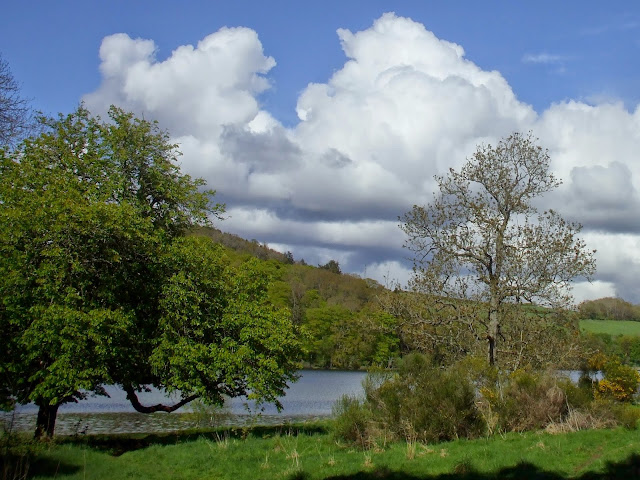Thankfully, the T-G hadn't bothered to lock up and it was fairly easy to gain access by sliding a stout piece of card between the two casements. Tuppence and I rolled up the Aubusson, tied it with rope, and shoved it out of the window. There was a lot of rustling as it slid down the ivy and the Moon was shining brightly upon the castle walls leaving us quite exposed to anyone who happened to be having a midnight ramble. However we had to take the chance because unless we tried to cram it through the waste hole of the 'garderobe' we had no other way of getting it out.
Back at the Outcrop we unrolled the rug. The map was clearly visible on the woven underside, rather than on the stained and worn 'pile'.
But what was it a map OF? Or indeed, where? We had to bear in mind that we were looking at a reverse image.
There were symbols for water, and a distinct outline of a tiny island. On the island was the symbol for a church, or at least some sort of religious structure.
And next to it, a skull and crossbones.
'What does that signify?' asked Geoffrey. 'Pirates?'
'Death,' said Tuppence. 'Poison. Disease. It's a plague island. Of all the rotten luck.'
'So we've wasted our time then,' said Geoffrey. 'The whole point of nicking the map was to find buried treasure. Gold coins, doubloons, pieces of eight and caskets of jewels. Because where there's a secret map there's always buried treasure. Not that we need munny or anything, it's just nice to have the satisfaction of finding it. Oh well, I suppose we'd better take the rug back before they notice it's missing.' He reached for the grappling hook.
'Hold up, Geoffrey,' I said. 'Could it be that the skull and crossbones IS a pirate symbol, rather than death or poison, and that there's smuggled treasure hidden there?'
'Or, perhaps whoever made the map wanted people to think it was a plague island to put them off and there is really a hoard of gold and jewels hidden in a crypt or something,' said Geoffrey.
'There's only one way to find out. We have to figure out which island this is and get over there quickstyle,' said Tuppence, twirling a pistol. 'Fetch the coracle Uncle Tuppy, while I fire up the iPhone and do a reverse reverse image search.'
next time - we find the island, only to discover it's already heavily featured as a fun destination on Instagrot and a million people and their kids have already trampled over it, paddle-boarding and barbecuing and defecating everywhere and destroying any potential clues...but the Old Tup was a canny character and nobody's fool. There were secrets yet to be discovered...and we were the ones to find them - with the additional help of Dave, his trailcam and his newly-developed, super-sensitive 'third eye'. More on that next time.






































